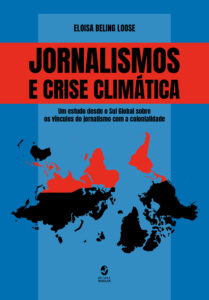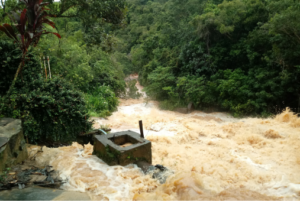The phenomenon El Niño and climate change slammed Latin America and the Caribbean in 2023, the World Meteorological Organization (WMO) said in a report released in early May. Droughts, heat waves, wildfires, extreme rainfall and a record hurricane that occurred last year have had impacts on health, food and energy security and economic development that will be felt “in 2024 and beyond,” it concluded.

Eloisa Beling Loose (Courtesy)
This analysis summarizes the climate situation that, from the perspective of journalism, crosses all news desks. Climate change and its effects challenge journalists to learn and deal with situations that were unimaginable just a few years ago and that are now becoming the new normal.
LatAm Journalism Review (LJR) spoke about this topic with Brazilian journalist Eloisa Beling Loose, researcher and consultant in the area of communication and the environment, with an emphasis on climate change. Loose is a professor at the Federal University of Rio Grande do Sul and member of the Environmental Journalism Research Group (GPJA, for its acronym in Portuguese). She has been dedicated to the subject for almost 20 years and recently launched the book “Jornalismos e crise climática: Um estudo desde o Sul Global sobre os vínculos do jornalismo com a colonialidade” (Journalism and the climate crisis: A study from the Global South on the links between journalism and coloniality).
“The environment is an issue of public interest that is in all newsroom beats. You will come across this topic, and if you do not have critical training and information to prepare a good story, you will be a mere reproducer of official voices,” Loose said.
She spoke to LJR about how journalism can contribute to deeper discussions about climate change and its causes – not just its devastating consequences. She also highlighted the importance of talking about climate disaster prevention and incorporating care for the environment into coverage.
Read the interview below, which has been edited for brevity and clarity.
1. Why did you decide to research environmental and climate journalism?
Eloisa Beling Loose: First, it's important to say that I understand that climate journalism is not so different from environmental journalism. It is a new way of dealing with environmental journalism, considering that the climate issue has gained wide visibility and is a very relevant part of the environmental crisis. But it is not a completely new journalism, it is not detached from the environmental debate.
I was a journalism intern at a university rural science center and realized that environmental issues could be discussed, but this focus was never a priority. I tried to understand why this happened and discovered that environmental journalism existed, but there were few references and little encouragement, from within the [university journalism] programs as well as within reporting. It was one supplement [on the environment] a week or a section that came out on a specific day. I imagined that I could work in a space like this and that this type of journalism would grow, but over time the specialized sections began to shrink and become extinct. Some point out that this coverage has become widespread and that is why these spaces no longer exist. But that was it: I identified that there were issues to be addressed, but that there was little emphasis. And I went looking for how to deal with this.
2. An Ipsos Global survey carried out in 2023 found that only 24% of the global population considers that media represent the impact of climate change well. Latin America is the region where people most feel that media underestimate the impact, and where they least believe that media exaggerate. Borrowing the survey question, would you say that media in Latin America underestimate, exaggerate or present a good representation of the impact of climate change?
There are few studies in the area of Communication in Latin America on climate change, mainly longitudinal research that shows us how this coverage is changing and how this affects [the public's] reaction. We don't have this data, so we work with very specific research, which takes a snapshot of a moment.
In general, when we talk about climate coverage – and several studies in Brazil and Latin America point this out – it is the consequences of climate change that are highlighted. Journalism finds it very difficult to discuss and highlight the causes of the climate crisis. It may even appear in the middle of an article: “climate change is caused by increased greenhouse gas emissions.” But what does this mean in people's lives? How can they understand this issue with what they do on a daily basis and with a problem that is happening now?
The impacts generally appear when the disaster breaks out, when the climate risk stops being an anticipation and becomes something concrete. This is precisely what journalism has the easiest time covering, so this has to appear. It is part of journalistic logic, and I don't think there is any exaggeration or sensationalism in relation to this, after all, the climate crisis is very serious and demands urgent action.
I don't believe there is a lack of [climate] coverage today. What can happen is that this coverage, with an emphasis on impacts, fails to move forward to also discuss the causes and possible alternatives for dealing with the problem.
3. In a column published in January this year on the website ((o))eco, you and Clara Aguiar, also a member of the Environmental Journalism Research Group (GPJA), wrote that the decolonial perspective, which criticizes colonial practices of exploitation, “is intrinsically related to the assumptions of environmental journalism.” How does this relationship work?
The discussion about decoloniality [school of thought that criticizes the Eurocentric pattern of power] enters Communication later than in other fields of knowledge. There are many things that have the 'label' of decoloniality that we have already been incorporating and discussing within the scope of the GPJA, based on readings by Latin American authors who bring this criticism about the relationship we have with nature through hierarchies and a series of explorations.
 Based on studies on environmental coverage from both mainstream/traditional journalism and independent or alternative media outlets, we began to think about where the assumptions or bases of environmental journalism came from, what consolidates what is different about environmental journalism from other journalism. How does it bring a perspective or contribution to observing these relationships [between humans and the rest of nature] in a more integrated way?
Based on studies on environmental coverage from both mainstream/traditional journalism and independent or alternative media outlets, we began to think about where the assumptions or bases of environmental journalism came from, what consolidates what is different about environmental journalism from other journalism. How does it bring a perspective or contribution to observing these relationships [between humans and the rest of nature] in a more integrated way?
We began to argue, based on these studies and the bibliographical references on the topic, that environmental journalism should have some elements to consider care of the environment in coverage, and not understand the environment only as an object. In general, what journalism does, based on hegemonic or dominant logic, is to see the environment as a natural resource. Journalism tends to report when the resource is missing, causing damage to the economy, or when there is an impact and involves a cost to resolve.
Our research group began to discuss what these assumptions should be. One of them is the plurality of voices. If we think, for example, about climate issues: who are the people who most feel the impacts of climate change? Journalism should not only listen to science, which is not a discrediting of scientific knowledge, but understand that there is popular and traditional knowledge, originating from experience, which needs to have space in the press and which is rarely heard today, even in media which they say oppose hegemonic logic.
Environmental journalism should also provide greater context. This is something that should be the norm in journalism in general, but increasingly it seems to become something present only in some types of journalism, because the day-to-day does not allow it, because there is a downsizing of newsrooms and because journalists are not specializing in this kind of journalism. Also the incorporation of environmental knowledge, which is understanding how the environmental field understands what is happening, because [in journalism] we work from a predominantly economic rationality. Therefore, it is important to know how the construction of the idea of the environment takes place historically and what interests are involved in these discussions, from the perspective of areas of knowledge that claim other ways of being in the world.
We learned a lot from thinkers in the environmental field and identified that there are processes that journalism does not usually look at. The very question of interconnections, which [Fritjof] Capra talks about, the web of life and how we are not autonomous beings, who can live in isolation. And this is present in hegemonic thinking: the possibility of progress and individual success is very different from anything we can observe from the interdependent relationships of nature. By learning from environmental knowledge, we can propose stories that can contribute to the collective interest and benefit society as a whole.
4. In May, Folha de S. Paulo started to have a climate correspondent, a position also recently created in other news media around the world, such as CNN and the Financial Times. What is your opinion on the creation of this position?
In the area of studies, there is a recurring discussion about what would be better for journalism: having specialized professionals [in environmental coverage] or making this perspective something common to all journalists.
There was a time when we thought that having a designated space [for environmental coverage] could show the public how there are different perspectives on this topic and how important it is. On the other hand, sometimes we had the feeling that, with that space well demarcated, many people who had a preconception that this was a matter only for environmentalists would simply skip the page. This way, they would not access content that, if it had been present in a more transversal way in coverage, they might have consumed.
At first, I understood specialization as a step until everyone understood the relevance of the topic and it became mainstream. That's not exactly what happened. In Brazil, when ECO-92 [the United Nations Conference on Environment and Development held in Rio de Janeiro in 1992] took place, there was a movement to train journalists and of newspapers opening sections to discuss environmental issues. After that, the proposal lost strength, spaces were closed, and environmental journalists became very expensive for newsrooms. There is a lot of environmental journalism today, but not so much in large newspapers. Environmental journalism today is widespread in digital media outlets, but it is difficult to measure its social reach.
I am in favor of there being journalists who are exclusively dedicated to climate or the environment, because they will be able to ask questions that depend on prior knowledge and to prepare stories that will bring greater depth to the public. At the same time, broader training also needs to occur. [Brazilian journalist] Sonia Bridi has said a lot that nowadays every journalist should be a climate journalist. And, at GPJA, we have been saying this for at least 15 years: the environment is an issue of public interest that is in all newsroom beats. You will come across this topic, and if you do not have critical training and information to prepare a good story, you will be a mere reproducer of official voices.

Major flooding in the Brazilian state of Minas Gerais. (Canva)
5. Extreme weather events have increased in frequency and intensity around the world, and Rio Grande do Sul recently experienced what has been considered the biggest climate disaster in the state's history. Other countries in Latin America have recently experienced extreme weather events and the trend, according to scientists, is that many more will come. What is your assessment of the coverage of these events, and how can it improve?
It is important to connect these disasters that are happening more intensely and frequently to climate issues. This seems obvious, but it does not always appear explicitly in coverage. Labeling the disaster as climate-related may be educational in this sense. The science of attribution [which verifies the influence of climate change on the increase in extreme weather events] happens in its own time, which does not always coincide with reporting deadlines. Furthermore, we will not have studies on all extreme events, but, in general, scientists say that yes, the trend is that increasingly, due to climate change accelerated by human action, these tragic events will occur. Based on what science already finds, it is possible to give more emphasis to actions to combat climate change that are directly associated with reducing risks and disasters.
Here in Rio Grande do Sul, when the disaster broke out, obviously the journalists' main concern was to provide a service to the population and try to organize the chaos of information. As journalism is very fact oriented, it covers what is happening at the moment very well, and in this coverage there is not much time to go deeper and discuss causes.
More than covering the response to the disaster, journalism needs to note that the disaster is a process that continues to occur after this initial moment. There is a concern among many journalists not to let the subject disappear. However, studies of previous coverage of other disasters show that it is common for journalists to only remember the disaster a year later, or five years later, during anniversaries. There is no follow-up showing how affected people managed or failed to return to “normality”; if they somehow managed to get their lives back on track. These people end up being made invisible.
This process also needs to include the denaturalization of the disaster. Journalism continues to name the disaster as natural, blaming the rains and not a general context that was caused by human decisions. A climate disaster is a concurrence that results from a threat, which in this case was intense rain, associated with a state of social vulnerability that was unable to adapt or react to this threat. This is because there was no prior attempt or prevention actions that could identify this threat and prepare the population to face it. When journalism says that a “natural disaster” has occurred, it seems that we have nothing to do as a public, as a society. If it's natural, what can we do about it?
However, when journalism manages to designate this disaster as a consequence of human actions that could be rethought and shows that the disaster is avoidable if these vulnerabilities are addressed, another understanding emerges. Journalism helps build the social imagination and this is a very relevant role. It is a precaution that needs to be taken when the authorities say that “it was the rain’s fault, there was no way to predict it.” Sometimes, due to lack of experience or because they think that the official source should have the headline space, this ends up being reproduced and people somehow internalize this understanding that, in fact, this disaster is natural, climate change is natural, so what can I do? I can not do anything.
It is also very important to talk about prevention. Journalism has difficulty working with anticipatory events, as this is seen by the journalistic community as speculation. But we have discussed among researchers, these logics need to be changed, because journalism can no longer wait for the risk to materialize as a disaster and only then talk about what could have been done to avoid the tragedy. Problems need to be reported in advance, because we already have information, so it makes no sense not to talk about it.
Prevention needs to be incorporated more systematically in order to contribute to another culture. Here in Rio Grande do Sul there were many cases of people who did not react to the warnings, and did not believe the worst predictions. The population is not prepared to deal with these warnings, and journalism could significantly help in this sense, if it were talking about prevention on a daily basis, not just at the moment the disaster happens.